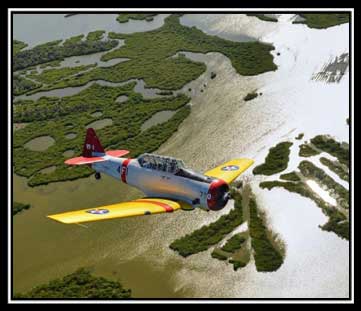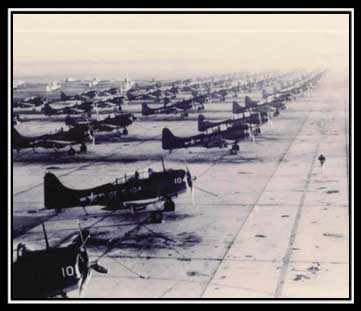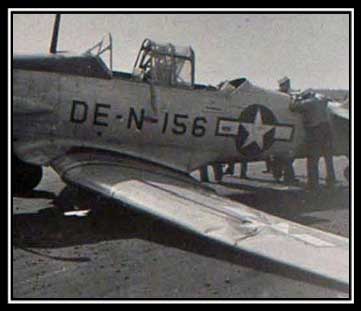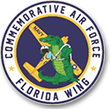The Florida Wing Gets a Texan
The year is 1944, and the state of Florida is saturated with flight training activities from all branches of the military services as the United States, embroiled in multiple fronts at the height of World War II, continues to produce combat aircraft at rates never seen before or since. Since the airplanes of the day were generally more effective with pilots (semantics), the military was doing all they could to create the necessary combat pilots who could go bring the war to the enemy. Florida proved to be a most ideal location for Navy, Marine, Army Air Corps, and even Royal Air Force flight training due to the consistently favorable weather conditions for flying in concert with solid local infrastructure. So it became that many of the existing civilian airfields were converted to military use, and when there wasn’t an airport to be found, the military built one. In 1944, these now military airports included every single one of today’s existing paved public use airports in the greater DeLand and Daytona Beach area. The Navy extensively used these particular airports to conduct advanced operational training for pilots in the aircraft types they would be taking into combat. The next stop for most of these men was in the Pacific Islands, where they would need to muster every ounce of precious training they received here; for they were about to go toe to toe with the fierce Japanese forces.
Here at the Florida Wing’s home base in DeLand, the Navy was conducting transition and combat training in a variety of aircraft types, but what was mainly found on our ramp and buzzing in the skies overhead were the hefty Lockheed PV-1 Ventura twin-engined patrol bombers and Douglas SBD Dauntless dive bombers. However, off on a separate portion of the ramp here, lived roughly half a dozen North American SNJ-4 Texan trainers, which served in a support role for the base administration.
Now, the primary function of the SNJ in the Navy was to train pilots in the intermediate and advanced phase of flying, which is the middle phase of flight training where the aircraft performance and complexity is substantially greater than the primary training airplane a student would fly first, thus introducing additional challenges to the pilot trainee. The next step after the SNJ would often be flying as pilot in command of a combat aircraft like a fighter, torpedo, or dive bomber. However, as was the case with the DeLand SNJ-4s, the Navy also used the SNJ series of aircraft in air station support, administration, and proficiency roles and colloquially referred to these types as “hack” aircraft. If a pilot required instrument flying proficiency checks, the SNJ-4 would be used as its dual cockpit configuration allowed for installation of a retractable hood that would cover the entire rear cockpit so as to eliminate a pilot’s ability to use outside visual reference to fly the plane, with navigation being conducted completely by instruments. Additionally, should a pilot, package, or communication need to be delivered to one of the many nearby airfields, or if landing proficiency was needed, the DeLand based SNJ-4 “hacks” were likely depended on.
Fast forward to today, 76 years later. The weather is still beautiful and NAS DeLand is now known as DeLand Municipal Airport. While the planes and names have changed, flight training is and still remains an important function of the airport; as of the time of this writing there are no fewer than six Embry-Riddle Aeronautical University Cessnas waiting their turn to takeoff for traffic pattern practice. Remnants of the former navy installation are plainly visible to anyone who visits, such as the Quonset huts that contained former base administration, remains of two of the former four runways that have long since been closed, or the old Master- at-Arms residence that’s now the home of the NAS DeLand Museum. Since 2003, the Commemorative Air Force Florida Wing has called DeLand Airport its home, and while our mission is and always has been the preservation and education of military aviation history, it was not until today that we had a real opportunity to finally bring a small piece of our own airport’s great legacy back to the skies of DeLand.
Queue the arrival the Florida Wing’s newest addition, a 1943 North American SNJ-4 Texan, FAA registration N224X. The Florida Wing was recently awarded stewardship of this flying monument to military pilot training history, and it now joins our beautiful T-34 in the Butch Stevens Hangar facility on the east side of DeLand Airport (DED). Before it was N224X, this SNJ-4 was Navy Bureau #27585 and was delivered to the Pensacola, Florida area in 1943 where it was operated from the various Navy airfields in western panhandle of Florida. Records indicate a majority of this SNJ’s life in Navy service occurred at Naval Auxiliary Air Station Whiting as an instrument trainer, and after spending a brief period in storage between wars from 1950 to 1952, was inducted back into Navy service, then finally retired after a stint in Naval Air Reserve Training at Grosse Ille, MI in 1956. The airplane was sold into civilian ownership in 1957 for the bargain price $1,810 (that’s $16,700 in today’s currency!) and was eventually acquired by its current owner, the Commemorative Air Force, in 1974. Before falling into the care of the Florida Wing, the CAF whereabouts of this SNJ included Lafayette, Harlingen, Abilene, Dallas, Cleveland, and the last caretaker of the plane was the Buffalo Heritage Squadron in upstate New York.
Research suggests that the paint scheme of the Florida Wing’s SNJ-4 reflects that of a typical Texan attached to Navy training squadrons like VN-3D8 in 1943 - which was the first squadron to have commenced operations at newly commissioned Naval Auxiliary Air Station Whiting Field that same year. However, the current markings do not corroborate to that era of naval aviation, and since the existing paint is quickly approaching the end of its useful life, a new paint job will be required sooner rather than later. As part of the Florida Wing’s efforts to best represent the rich Naval Aviation history of DeLand, Florida, fundraising is underway to adorn N224X with the colors and markings of the SNJ-4 hacks that once called our airport home in 1944. As such, our N224X crowdfunding campaign still active on the CAF’s 12 Planes of Christmas fundraiser website.
With that in mind, this aircraft presents an opportunity and a responsibility that is not taken for granted at the Florida Wing. Strategic plans and partnerships have been drawn up and cultivated to support this fuel-hungry flying machine (known to humble pilots of all experience types) for the years to come. The Florida Wing has been able to enlist the help some of the top Texan talents in the southeast to perform the induction annual inspection, prepare the pilot training program, and begin the introduction into service - specifically, former AeroShell Aerobatic Team slot pilot and Texan guru Gene McNeely. Col. McNeely has been an unbelievable resource to the Florida Wing with our SNJ. He and his team of mechanics have dedicated hundreds of hours of labor in restorative work on N224X to date, which culminated with him issuing the plane a clean bill of health for the year after a very thorough and involved annual inspection. Additionally, Gene (who has over 6,000 hours in Texans) has made himself available as one of our instructor pilots, where he continues to volunteer his wealth of experience to our organization. We’re also indebted to one of our program organizers and chief contributors Col. Pat Foley. A fomer T-6 owner and operator himself, Pat knows this airplane and the parts network to support it like the back of his hand. When a part is needed, Pat sources it in record time, which in turn has kept any airplane downtime at an absolute minimum. We would also be remiss if we didn’t thank the Capital Wing in Culpepper, Virginia for providing hangar and ferry support to this SNJ during some of the most turbulent times of the ongoing global pandemic. Of course none of this would be possible without the CAF headquarters, the group that continues to support us all, but especially us at the Florida Wing. Without their help none of our increasingly more ambitious endeavors can even leave the drawing board!
It goes without saying that the Florida Wing is overjoyed to be selected as the next keeper of the keys for this historic warbird. While N224X did not spend its service life at NAS Deland, the idea of returning a real specimen of WWII aviation history to life, of a type that once lived not but a few hundred yards from our present spot here at DeLand, is an inspiring charge and continues to fuel our unit’s passion for restoring Naval Aviation to this hallowed ground we call home. We invite all CAF personnel and general public alike to come visit our ever-growing facility at the DeLand Airport (instructions can be found on the FL Wing website). When our T-34, and now SNJ-4, aren’t flying, they are resting in our hangar which is also home to the Bob Robbins Memorial Library and Museum. We especially welcome anyone who embodies our mission - who want to get involved in supporting efforts to further education of the military aviation history that shaped our country, to inspire future generations to be involved in flying and aviation preservation, and to maintain and operate these flying tributes in a manner befitting to the brave men and women who served this great nation. It is because of the help of our members generosity, local community support, and CAF members near and far who share our same passion, that the Florida Wing SNJ will become a proud reminder of what was accomplished in our backyard during some of the most trying times of our country. N224X will be a beacon of Central Florida WWII heritage... and we can’t wait to show it off!

The Florida Wing SNJ-4 currently wears colors similar to those found on many of the 1943 Pensacola area squadrons, while the squadron markings are from a different era and were never worn on an SNJ. Research suggests this particular aircraft may have been among the first to conduct Navy flight training out of NAAS Whiting in the late spring of 1943 with VN-3D8; just prior to the air station’s official commissioning that summer. |

NAS DeLand Flightline circa 1944. Note the group of SNJs in the top left. The Florida Wing’s hangar is now located in the field behind the SNJs. |

This NAS Deland SNJ-4 experienced a landing mishap at NOLF New Smyrna. Markings DE denote NAS DeLand. N indicates the airplane is attached to a miscellaneous training unit. The plane is the 156th aircraft in the unit. |











